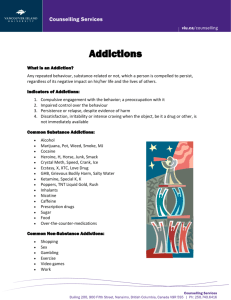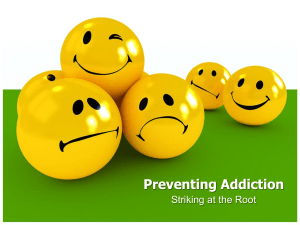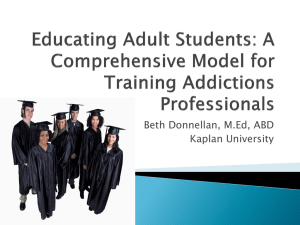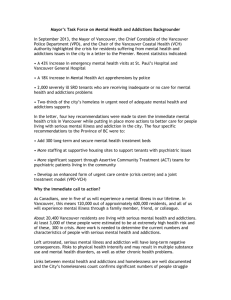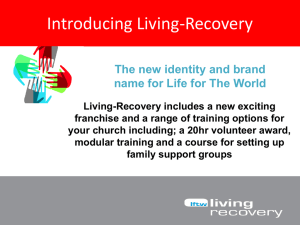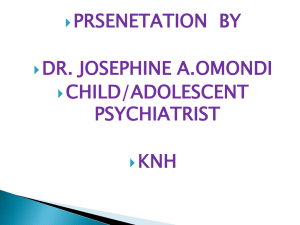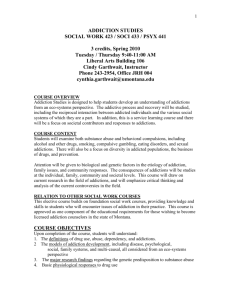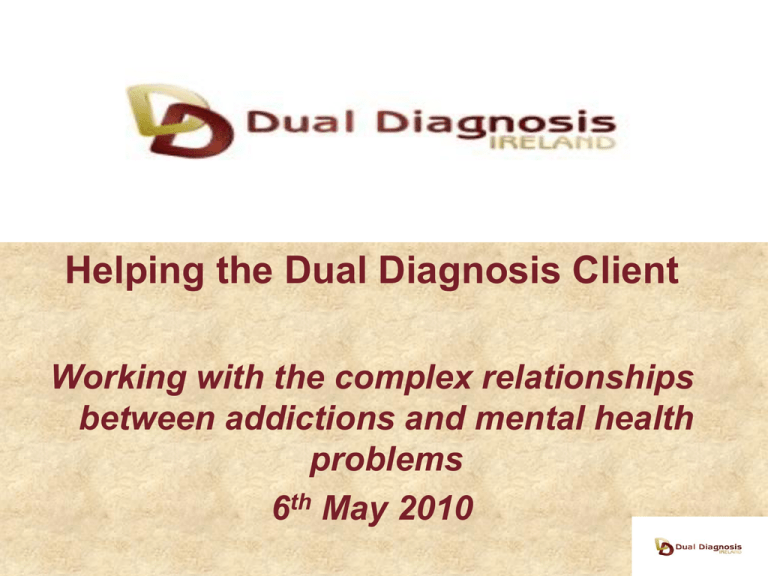
Helping the Dual Diagnosis Client
Working with the complex relationships
between addictions and mental health
problems
6th May 2010
A person who has both a
(substance) addiction problem and an
emotional/psychiatric problem
is said to have a dual diagnosis.
The concept arises because addictions
are not seen in the same way as other
mental health problems – addiction is
often not thought of as a mental health
problem.
To recover fully, the person needs
treatment for both problems.
Common MH Problems in DD
Depressive disorders
– Depression
– Bipolar disorder
Anxiety disorders
– Generalised anxiety
disorder
– Panic disorder
– OCD
– Phobias
Other psychiatric disorders,
– Schizophrenia
– Personality disorders
– ADHD,PTSD
Common Addictions in DD
Substance Addictions
Alcoholism
Street drug addiction
Prescribed drug
addiction
Behavioural Addictions
Gambling addiction
Sex addiction
Food addiction
DSM-IV Criteria for
Depression
•
•
•
depressed mood most of the day, nearly every day, as
indicated by either subjective report (e.g., feels sad or
empty) or observation made by others (e.g., appears
tearful). Note: In children and adolescents, can be irritable
mood.
markedly diminished interest or pleasure in all, or almost
all, activities most of the day, nearly every day (as
indicated by either subjective account or observation made
by others)
significant weight loss when not dieting or weight gain
(e.g., a change of more than 5% of body weight in a
month), or decrease or increase in appetite nearly every
day. Note: in children, consider failure to make expected
weight gains.
Contd.
• insomnia or hypersomnia nearly every day
• psychomotor agitation or retardation nearly every day
(observable by others, not merely subjective feelings of
restlessness or being slowed down)
• fatigue or loss of energy nearly every day
• feelings of worthlessness or excessive or inappropriate guilt
(which may be delusional) nearly every day (not merely
self-reproach or guilt about being sick)
• diminished ability to think or concentrate, or indecisiveness,
nearly every day (either by subjective account or as
observed by others)
• recurrent thoughts of death (not just fear of dying), recurrent
suicidal ideation without a specific plan, or a suicide attempt
or a specific plan for committing suicide
DSM-IV Diagnostic Criteria for
Substance Dependence
A maladaptive pattern of substance use, leading to clinically
significant impairment or distress, as manifested by three (or
more) of the following and occurring at any time in the same 12month period,
1)
a)
b)
2)
a)
b)
Tolerance, as defined by either of the following:
a need for markedly increased amount of the substance to
achieve intoxication or desired effect;
markedly diminished effect with continued use of the same amount of the
substance.
Withdrawal, as manifested by either of the following:
the characteristic withdrawal syndrome for the substance
the same (or a closely related) substance is taken to relieve or avoid
withdrawal symptoms.
1.
The substance is often taken in larger amounts or over a longer period than was
intended.
2. There is a persistent desire or unsuccessful efforts to cut down or control
substance use.
3. A great deal of time is spent in activities necessary obtain the substance, use the
substance, or recover from its effects.
4.
Important social, occupational or recreational activities are given up or reduced
because of substance use.
5.
The substance use is continued despite knowledge of having a persistent or
recurrent physical or psychological problem that is likely to have been caused or
exacerbated by the substance.
e.g. Unclear thinking, irritability, sleep problems, loss of interest,
social withdrawal
N.B. - Progressive Loss of Control & Damage in all areas
Significant distress
Assessment of Dual
Diagnosis
The possible relationships
between addictions
and psychiatric symptoms or
disorders
are the following:
(according to McDowell & Spitz, 1999):
1. Primary Mental Illness
Many psychiatric disorders can lead to symptoms
associated with many addictions.
Example:
Depression
Alcoholism
Pathways: Self-soothing, self-medicating, selfdamage +?
2. Primary Addiction, including Withdrawal
Symptoms:
Many addictions can lead to symptoms associated
with almost any psychiatric disorder.
Example: Alcoholism
Depression
Pathways: Physiology, behaviour, cognition
+?
3. Simultaneous and independent conditions.
One disorder may prompt the emergence of the
other, or the two disorders may exist independently.
Example:
History of Depression (inc. family)
History of Alcoholism (inc. family)
Interaction pathways as above
Clues to Primary Problem
(not always clear)
• Began before serious secondary problem
• Persists during remission periods of
secondary problem
• Severity of symptoms in relation to
moderate levels of secondary problem
• Chronic, acute, uniqueness of symptoms
• Family history
Approaches…
Person-Centred:
•Necessary but not sufficient
•Doesn’t invalidate diagnostic categories
Case Formulation, including Common Factors/Themes:
•Common Mood Issues
•Common Motivational Issues
•Common Cognitive & Behavioural Issues
Alcohol Dependence & Depression
Themes of Mood/Reward, Motivation, Cognition,
Behaviour
Issue
Depression
Alcoholism
Mood
Low
Low + mood shifts
Expectation of Reward
Low
High
Experience of Reward
Low
Decreasing
Motivation for change
Low
Ambivalent
Self-belief
Low
Low
Negativity re future
High
High
Social withdrawal
High
Progressive
Self-care
Low
Low
Sciacca etc:
Motivational Interviewing +
Cogntive Behavioural
Therapy
www.dualdiagnosis.ie
http://users.erols.com/ksciacca
http://integrativecbt.blogspot.com
Cycle of Change
CBT Symptom Cycle
Thoughts
Emotions
Behaviour
Physiology
TYPES OF DISTORTED THINKING
1.
All-or-nothing thinking: You look at things in absolute, black-and-white categories.
2.
Overgeneralization: You view a negative event as a never-ending pattern of defeat.
3.
Mental filter: You dwell on the negatives and ignore the positives.
4.
Discounting the positives: You insist that your accomplishments or positive qualities "don't count.“
5.
Jumping to conclusions: (A) Mind reading: you assume that people are reacting negatively to you when
there is no definite evidence for this; (B) Fortune-telling: you arbitrarily predict that things will turn out
badly.
6.
Magnification or minimization: You blow things up way out of proportion, or you shrink their importance
inappropriately.
7.
Emotional reasoning: You reason from how you feel: "I feel like an idiot, so I really must be one." Or "I
don't feel like doing this, so I'll put it off.“
8.
Should statements: You criticize yourself or other people with "shoulds" etc.
9.
Labeling: You identify with your shortcomings. Instead of saying, "I made a mistake," you tell yourself,
"I'm an idiot," or "a fool," or "a loser.“
10.
Personalization and blame: You blame yourself for something you aren't entirely responsible for, or you
blame other people and overlook ways that your own attitudes and behavior might be contributing to a
problem.

